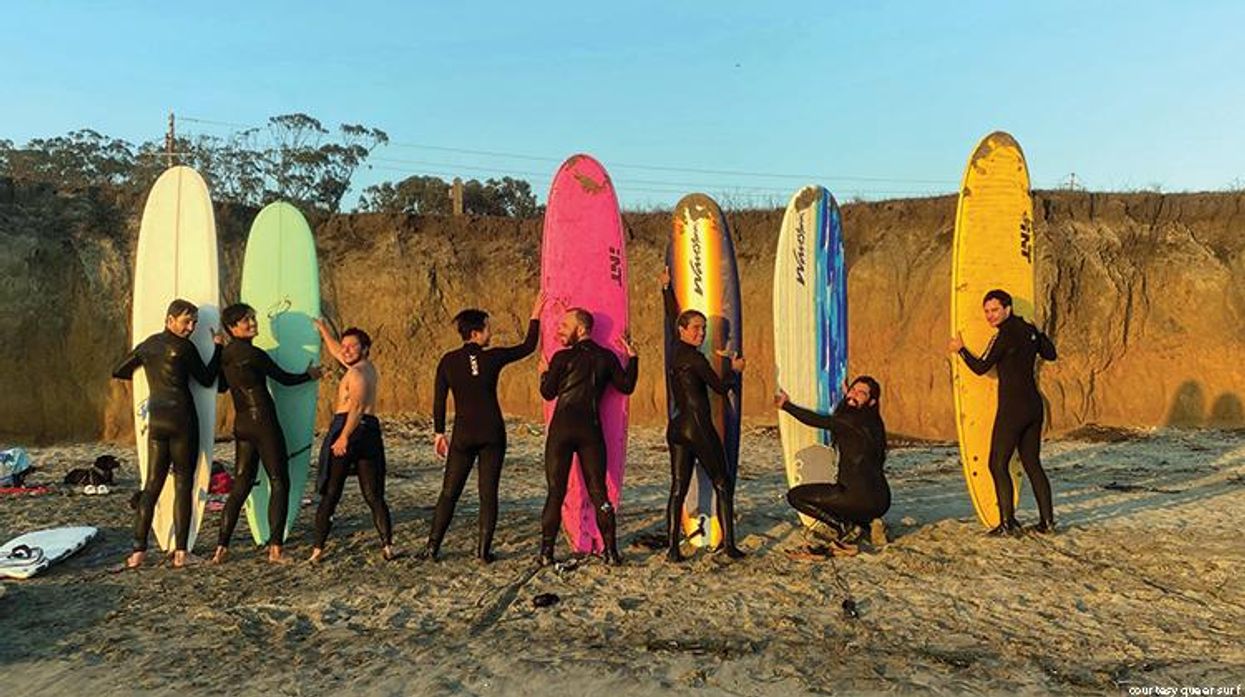Print Issue
This Group is Making the Waves More Welcoming for LGBTQ+ Surfers

San Francisco’s Queer Surf wants to make learning to surf less intimidating for the LGBTQ+ community.
March 14 2022 8:15 AM EST
By continuing to use our site, you agree to our Privacy Policy and Terms of Use.

San Francisco’s Queer Surf wants to make learning to surf less intimidating for the LGBTQ+ community.
Learning to surf can be intimidating. Even if waves were the only factor involved, the sight and sound of them — their curling, gurgling, pummeling majesty — is enough to get a newbie’s heart racing before they take a single step toward the water. Throw in the discomfort of donning a wet suit, the strength and balance required to begin paddling out into the water, and the sport’s white, masculine, heteronormative, cisgender tradition, and it’s almost uninviting, especially for LGBTQ+ folks.
San Francisco’s Queer Surf is trying to change that. Founded in 2015 by former pro surfer Kyla Langen and her partner, Nicci Brisebois, Queer Surf (queersurf.org) is doing its part to make the sport more diverse and approachable by tailoring surf lessons to the LGBTQ+ community.
“Surfing is part of the California dream, right?” Brisebois says. “We’d be out and about in the queer community in San Francisco and folks would ask Kyla, ‘Do you teach surfing? Would you teach me how to surf?’ We felt like there was an opportunity there.”
Brisebois also had personal experience trying to break into the sport. “I was afraid to get a lesson,” she remembers. “Feeling affirmed in my gender or comfortable being myself out in the lineup, whether I’m effeminate or nonbinary, is a big theme. Those guys giving the lessons, sometimes it’s like ‘OK, girls,’ ‘OK, ladies.’ It’s exhausting. At Queer Surf, there’s none of that.”
Queer Surf group lessons — which take place at various beaches along the California coast — begin with a friendly round of introductions followed by a walkthrough of oceanography, various swells and surf forecasts, and a session of on-sand paddling. Once participants take to the water, there is an unquestionable sense of safety, solidarity, and belonging.
It’s what Langen, who grew up in Carlsbad, California, and first surfed on the front of her dad’s board at age 4 before getting serious at 12 and eventually going pro, has always wanted of the sport.
“I would get ‘You surf good for a girl,’ so many times,” Langen recalls. “At first, I was flattered. Then I’d get a lot of guys who were competitive with me the moment they saw me do a turn. It started feeling like a rift, like just me being here is a problem.”
Being queer was another “problem,” something Langen felt she had to hide from the surf industry at large.
“There always was a major queer surf community, but we couldn’t be out,” Langen explains. “We were out to each other. We all knew everybody’s partners, but it was definitely a ‘don’t ask, don’t tell’ situation. That was explicitly stated a couple times by team managers and people in the industry.”
Thus, Langen’s motivation to launch a fresh wave on her own terms with Queer Surf.
“It’s embracing all levels of surfing, surfers who have felt isolated and people who want to learn, creating an avenue to feel celebrated as they’re trying to figure it out,” Langen says. “We meet people at their level and don’t use traditional measures of success. Standing up on your first lesson is not the end goal.”
The organization aims to make the water a safe place and also a fun place.
“There are so many people who come to us with a lot of trauma around the beach and ocean,” Brisebois says. “With traditional ideas of gender and expectations, being in the water is scary. With surfing alone, Mother Nature and men are two challenging things. You see people not wanting to wear bathing suits, not feeling comfortable in their queerness at the beach, but also wanting to be there, wanting so bad to connect with the water. That’s what we are, a celebration of being at the beach and being playful in the water.”
“It makes surfing more accessible when standing up and shredding is not the goal,” Langen adds. “It’s about being in the water and feeling healed. Arriving in the water, being in your body and feeling honored and celebrated.”
This piece originally ran in Out Traveler print magazine. The Winter 2022 issue is now available on newsstands.